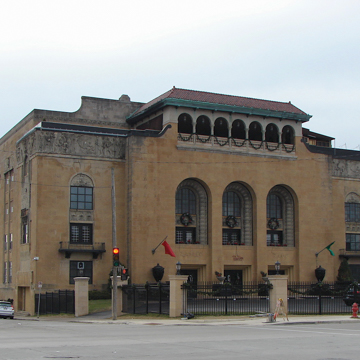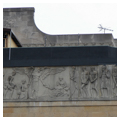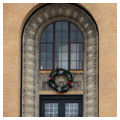This clubhouse once played roost to the nation’s largest aerie (chapter) of the Fraternal Order of Eagles, established in 1898 for charitable and recreational purposes. The facade is dominated by a broad central pavilion with three large entrance arches, culminating in a short arcade of rope-twist columns, which with the roof tiles are characteristic Mediterranean Revival features. Each side of the building incorporates a dramatic frieze depicting human figures in low relief, some with wings and eagle heads, striking theatrical poses. The eagle-headed figures refer to the building’s occupants, as do the stylized eagle tympana over the third-story windows flanking the central pavilion. Two sculpted eagles formerly perched on urns atop the pavilion. Inside the clubhouse, visitors pass a mosaic eagle in the lobby on the way to the athletic and social facilities. The top floor has a cavernous, oval auditorium, ringed by columns topped with eagle-head capitals, supporting a huge dome. In the 1920s, this “Million Dollar Ballroom” was one of the nation’s largest, seating more than 6,000 and hosting political and social events, concerts, and Broadway theater troupes. Many of this aerie’s founding members in 1901 were actors, stage managers, and others connected to the theater business, which explains why an impressive performance hall fills their clubhouse.
This aerie boomed in popularity after World War II. In 1966, Father James Groppi led local National Association for the Advancement of Colored People (NAACP) demonstrations at the club and its members’ homes to protest the club’s white male membership policy. The aerie disbanded in the mid-1980s, and the hall became a nightclub in 1998.







